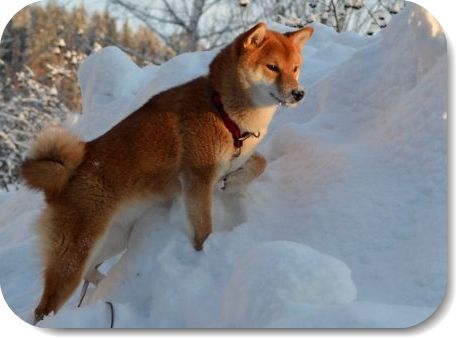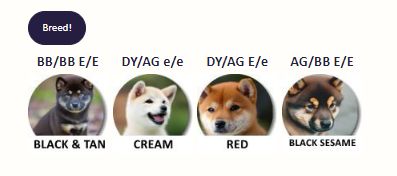The First Shibas in Europe
The first known Shibas of Europe arrived in the early 1970s to the Swedish Kennel Manlöten owned by Inga and Bror Carlsson. Swedish yearbook Hundkalendern 1976 featured a fascinating article, in which Inga Carlsson introduced her Shibas and the breed in general. Below you will find an English translation of this historical text. Original text and all images (c) Inga Carlsson.
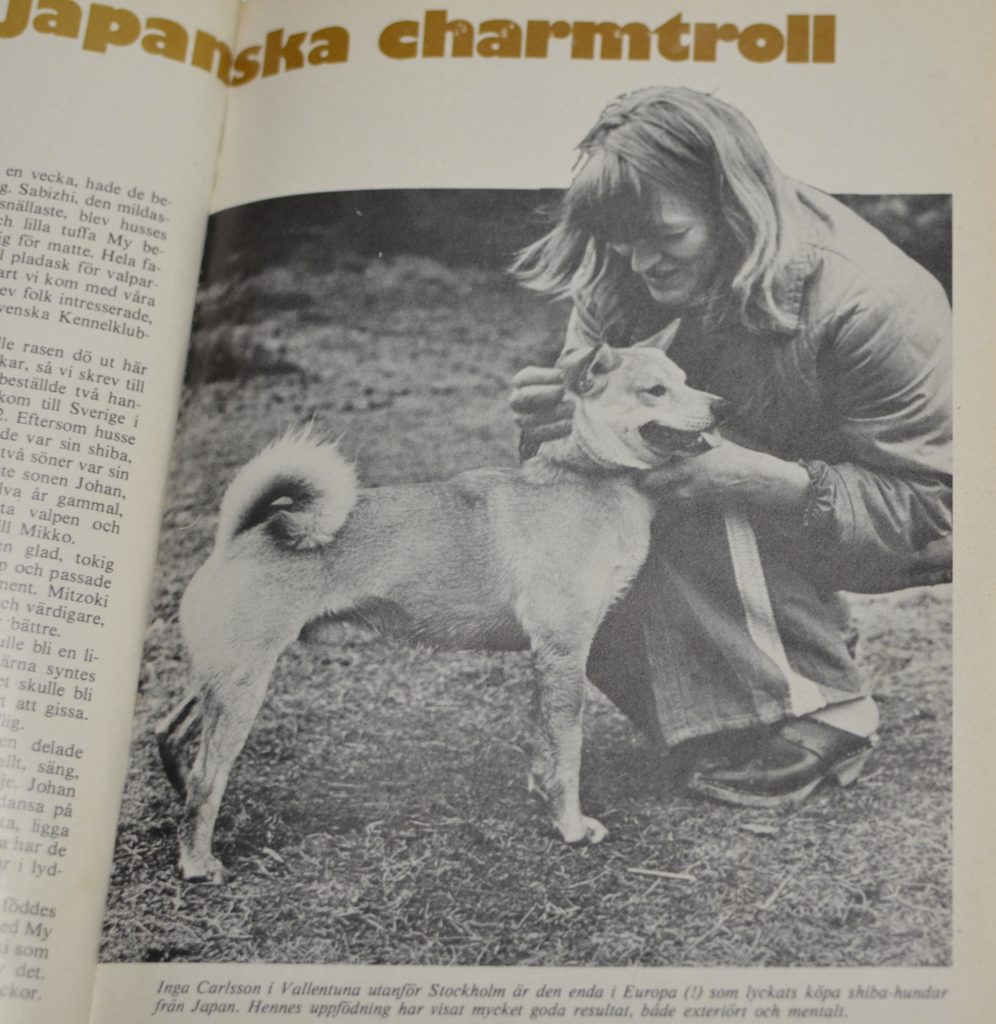
Shiba, my Japanese charmer
”Shiba, what is that?” I asked my Japanese colleague when he inquired if we had any Shiba dogs in Sweden. He told me that Shiba is a small, sturdy dog about 35-41 cm in height, and of the Spitz-type. Shibas were absolutely his favorites.
I was sceptical that I’d get interested in Shibas myself. I had always owned large dogs, and like many other people I was prone to thinking that dogs with a curly tail tended to bark and bite. Then I saw a glimpse of Shiba dogs, and refused to believe that they weren’t any bigger. They seemed to be around 60 cm in height, and looked so ”real”.
I became interested, and ordered the Shiba breed standard from FCI and Japan. Every praising word by my Japanese colleague matched well the breed standard. Shiba is supposed to be a lively, cheerful and enduring dog, who is faithful to his master. Shiba learns quickly and works eagerly. Shiba is quiet, and barks only when he wants to notify his master of something. In Japan, Shibas are used for hunting, pulling, and guarding. (A guard dog of 35 cm, I laughed back then. Now I feel sorry for anyone who’d try to intrude our home if I tell Lilla My to protect her mistress.)
The Japanese regard Shiba as ”an outdoor dog”. They are apparently thousands of years old. Skeletons of Shiba dogs have been found t.ex. in Jomon Era ruins, and they look similar even today. The Japanese have most of all bred good working dogs and ensured that Shiba has remained healthy, both mentally and physically. It is mentioned in the Japanese breed standard that Shiba is naturally sophisticated, not in a flashy but in a thoughtful way.
It was the Shiba head that fascinated me the most in photos. It is different from other dogs. The shape of the head itself appear octagonal, and the eyes are slanted in an Oriental manner. The head resembles more a wolf head than a dog head.
It didn’t take long until I was ”sold”. I was going to have a Shiba! This was when things got complicated. It is not easy to get into contact with the Japanese breeders. Besides, it’s difficult to get the Japanese breeders to sell. But I was lucky, and after a year of exchanging letters it happened. Two little female puppies would be shipped to Sweden.
On May the 28th in 1972 were a half-hysteric mistress and a totally calm master standing in Arlanda, waiting for the plane from Tokyo. It’s difficult to say who was happier when the dog cage at last arrived, the puppies as they got out of the cage, or I as the puppies were finally here with me. In the end it was the most heartwarming welcoming ceremony with kisses, licks, and hugs.
After the puppies has lived with us for a week, they had made up their minds. The gentle and kind Sabizhi would become my husband’s girl, and the small and brisk Lilla My chose me. Our whole family was infatuated by the puppies, and people showed interest in them no matter where we went – including the Kennel Club of Sweden.
To keep the breed alive over here I wrote to Japan and ordered two male puppies. They arrived to Sweden in December 1972. Because the master and mistress already had a Shiba, both of our boys got a male puppy of their own. Our younger son Johan, who was eleven years old back then, got the smaller puppy and named him Mikko. Mikko was a happy, cheerful and energetic puppy, who matched well Johan’s temperament. Mitzoki, who was a calmer and more careful puppy, was suitable for the big brother.
It was already obvious that Mitzoki would grow up to be a little star of dog shows, but it was challenging to guess what would become of Mikko. He was simply joyous. Starting from day one Johan and Mikko shared everything, be it bed, candy, happiness, or worries. Johan began to train Mikko to dance on his hind paws, to sit, to lay down, and to pull the cart.
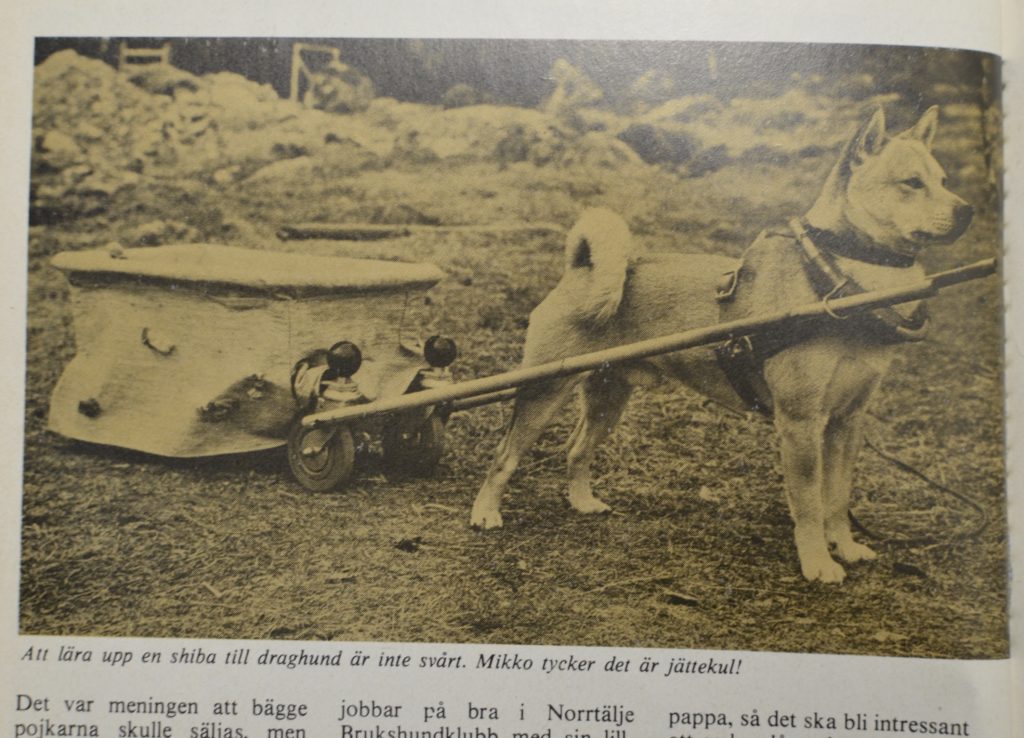
The first litter of My and Mitzoki was born on the 11th October in 1973. There were four puppies. Two boys and two girls. We were originally planning to sell both boys, but then the mistress looked too deeply into the slanted eyes of the first-born boy, and so Bokai stayed home with us. And we don’t have any regrets! He is a wonderful dog, both beautiful, kind, and quick to learn.
The mistress and Bokai are also competing a little in obedience trials, but so far Johan and Mikko have been able to beat us. Bokai has turned out to be a hard-working tracking dog. He cleared the track course on his 3rd training session, which appears to be a remarkable achievement. Bokai’s brother Banzai is working in the Norrtälj Working Dog Club with his young master. It doesn’t matter that the working dog people jokingly teased us in the beginning and in all friendliness called our Shibas guinea pigs – they shut their mouths when they saw what ”the pooches” were able to do. In the finals Bokai placed the 4th – among 17 dogs.
In January 1975 Mikko became a father, and Johan was allowed to keep Mikko’s daughter Emiko. He calls the dog Emma, and has already begun training Emma. Emma has proved to be as smart as her father – it is going to be interesting to see how far they’ll get in obedience trials.
Johan is involved in the Apollo group with his dogs, and he is campaining for the fact that small dogs, too, are able to learn, and that they actually should take part in obedience training. Training should always be disguised as play, and take place with the help of tasty treats.
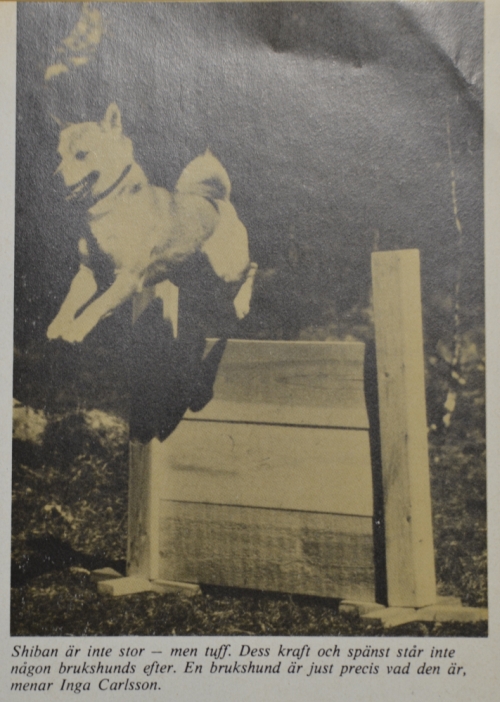
We have no idea how Shibas would perform as hunting dogs. Our dogs have grown up with our old cat Daphne, a miniature rabbit, and a small herd of sheep. We have not noticed any hunting instinct in them. But one of the female puppies, Dijini, is currently living in Småland, and her master is an elk hunter – perhaps she will join the hunt next autumn.
Right now the dogs compete over who can adopt our small, bottle-fed lamb, who is living in the kitchen. They are careful with the lamb, but can be quite tough to each other. Shibas like to form an internal hierarchy and then stick to it. They will protect their puppies from any external danger, but a cheeky puppy will soon know his place. It is this naturalness that I respect the most in Shibas.
You should never ask a breed enthusiast about the negative points of their breed. It is always difficult to think of the answer, even if there must always be something about every breed that could be improved. The Shiba coat is troublesome for 2-3 weeks every spring, because that is when they lose the thick undercoat. For the rest of the year they barely require any brushing. For some dog owners, the Shiba attitude ”I’m the biggest, best and prettiest!” can get troublesome. Bokai has earned a nickname ”Cassius Clay”. I find this attitude fascinating and like it, because on the other hand, Shiba is such a kind, happy and enjoyable dog for his own family.
Shiba dog truly is a big dog in pocket size – and truly a huggable teddy bear at the same time.
Inga Carlsson, 1976
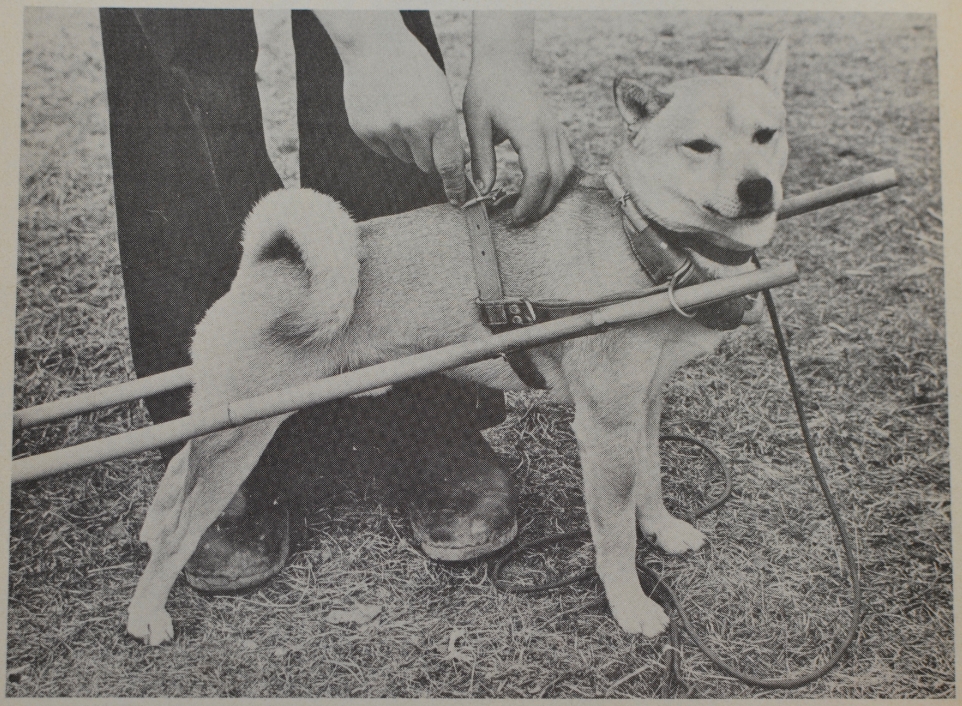
Extraordinary dogs
There are only 12 Shiba dogs in the whole Europe – and they are all imported or bred by Inga Carlsson! People from France, England, Netherlands, Germany and other countries have tried to purchase Shibas from Japan, but earlier nobody else has had any luck. Inga Carlsson must have had extremely good contacts!
Even if Shibas are smaller than actual working dogs, they seem to possess the toughness and spirit for working. It is very interesting to see how they will fill the expectations in the future. Perhaps the working dog people will be forced to change their opinion on only large dogs being usable as working dogs…
Importing new breeds to our country has become very popular. Sometimes one might even think that there are needlessly many new breeds. But these novelties from Japan – both the Japanese Spitz (which was introduced in the previous issue of Hundkalendern) and the Shiba alike are newcomers, which are a joy for the eye. They have come here to stay – of that we can be certain!
Hundkalendern 1976
Note! In reality, the first registered Shiba might have arrived to Denmark already in 1969. The editor of Hundkalendern was likely not aware of this dog back then as it is still difficult to find any additional information. Source: https://shibainfo.com/?page_id=62
